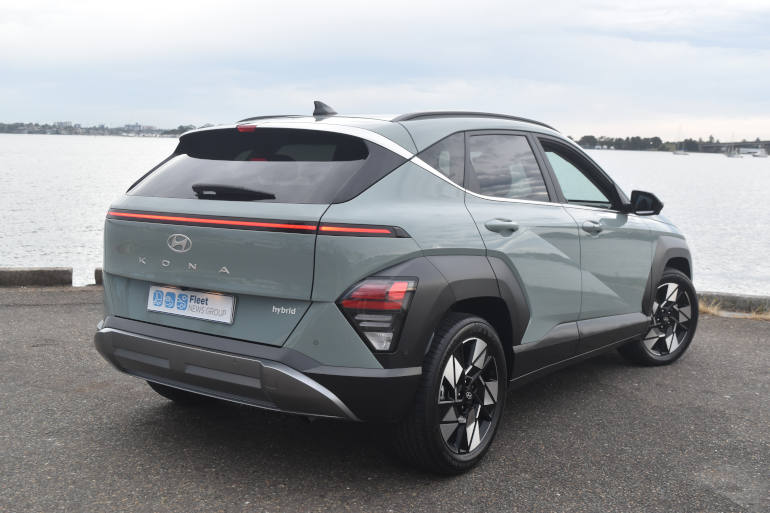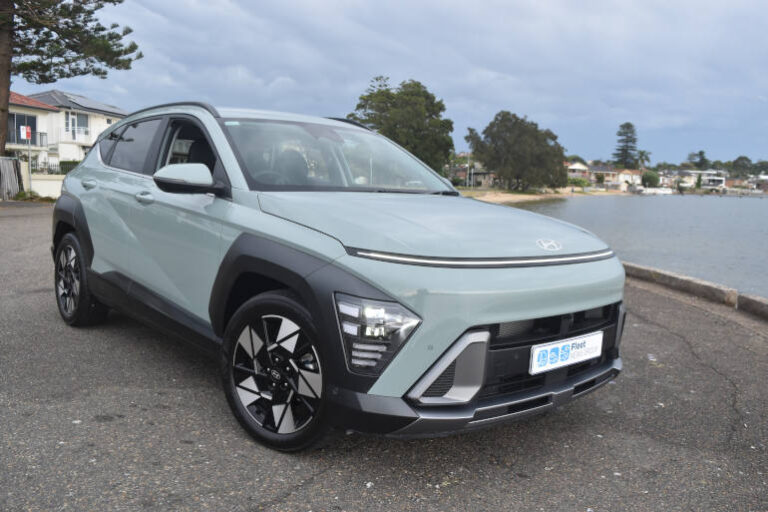If you’re looking for a small SUV that turns heads, sips fuel, and doesn’t give you range anxiety, the Hyundai Kona Hybrid might just be your new favourite set of wheels. Whether you’re a fleet manager trying to lower your emissions profile or a savvy private buyer looking to salary package your next ride, this next-gen Kona is worth a serious look.
Looks That Stand Out – For Better or Worse
Let’s start with the styling, because this is not a car that blends into the background. The Kona’s design evolution has taken a bold leap into the future. Up front, a full-width daytime running light strip gives it a proper sci-fi vibe – think Battlestar Galactica meets Back to the Future. At night, it lights up like something out of a Marvel movie.
It’s not traditionally “pretty,” but it grows on you. And from the rear, the design echoes the front with another full-width light signature and sharp, angular details. It’s futuristic, different, and – crucially – easy to spot in a crowded carpark.
What’s Under the Bonnet?
This hybrid version combines a 1.6-litre four-cylinder petrol engine with an electric motor. Combined, you’re getting 104 kW of power and a healthy 265 Nm of torque. That’s plenty for zipping around town and overtaking on country roads. Power is sent to the front wheels via a smooth 6-speed dual-clutch transmission.
It’s not a sports car – and it doesn’t try to be – but it’s responsive and comfortable. Hyundai claims combined fuel consumption of just 3.9 L/100km, and even if you don’t quite hit that in real-world urban driving, you’ll be sipping fuel rather than guzzling it. CO₂ emissions are listed at 89 g/km, which equates to just 1.78 tonnes annually based on 20,000 km of driving – a strong selling point for any emissions-conscious fleet buyer.
Interior: Premium Comfort, Everyday Practicality
Inside, the Kona Hybrid Premium feels more upmarket than you’d expect at this price point. Leather-appointed seats (heated and ventilated up front, heated in the rear), a leather-wrapped steering wheel, and dual digital displays give it a modern, tech-forward vibe. Wireless Apple CarPlay and Android Auto are standard, and there’s a wireless charging pad up front.
The infotainment and driver display are technically two separate screens, but they’re so well integrated they appear as one sweeping panel. Climate controls are physical buttons – hooray! – making it easy to adjust settings without taking your eyes off the road.
There’s decent storage throughout, clever cupholder mechanisms, and thoughtful touches like rear air vents and USB-C charging ports. Rear seat space is generous for a small SUV, with excellent leg and toe room for adults or growing teens. The boot offers 407 litres of space (up to 1,241 litres with seats folded) and includes a temporary spare tyre – better than a can of goo, but not quite as good as a full-size spare.
On the Road: Quiet, Comfortable and Capable
The Kona Hybrid is lovely to drive. Around town it’s whisper-quiet in EV mode, with the petrol engine kicking in seamlessly when needed. At highway speeds, it still feels composed, with enough grunt to confidently overtake when the need arises.
There’s a Sport mode if you want to dial things up, but most drivers will stick to Eco or Normal. The light steering and compact size make it a breeze to park and manoeuvre. Hyundai’s push-button gear selector takes a little getting used to but works well once familiar.
Safety tech is extensive: adaptive cruise control, lane keep and lane follow assist, blind spot monitoring, rear cross-traffic alert, and more. One small gripe? The traffic sign recognition system is a little overzealous with its beeping – yes, you can turn it off, but it resets every time you restart the car.
It’s worth noting that the Kona Hybrid only received a 4-star ANCAP safety rating. For some fleet managers, that might be a sticking point. While it’s still a very safe car, many fleets require a 5-star ANCAP rating for new additions – something to keep in mind.

Fit-for-Purpose: Who’s It For?
This is a car built for the daily grind. School runs, work commutes, city errands, weekend getaways – it does them all without fuss and with minimal fuel usage. Fleet buyers looking for a small SUV that meets city and regional needs – think council inspectors, health workers, sales reps – will find plenty to like here.
For private buyers, particularly those considering a novated lease, it ticks a lot of boxes. It’s affordable to run, easy to live with, and comfortable to drive. You get hybrid benefits without the premium (and infrastructure reliance) of a full EV.
It’s also a good long-term investment. The hybrid model should hold its value better than the petrol-only version, especially as emissions targets tighten and fuel costs continue to rise.
Ownership: Hyundai Has You Covered
The Kona Hybrid is backed by Hyundai’s 5-year unlimited kilometre warranty, with the hybrid battery covered for 8 years or 160,000 km. Servicing is required every 12 months or 15,000 km, and roadside assistance is included for the first 12 months – with extensions available if you service through Hyundai.
For fleet managers and salary packagers, that means peace of mind and predictable running costs.
Price and Value
Here’s where it gets interesting. The Kona Hybrid Premium starts at $47,864 drive-away in NSW. Add $295 for optional leather seats (yes, even in the Premium trim – a bit cheeky). Total: $48,174.
Compare that to the same trim in petrol-only format: $44,038 drive-away. So, a $4,000 difference between petrol and hybrid. Over the life of the vehicle, the fuel savings alone could claw that back, especially for higher-kilometre drivers.
A full-electric Kona Premium? That’ll set you back $74,086 drive-away. So the hybrid sits in the sweet spot – cleaner than petrol, cheaper than EV, and no range anxiety.
Competitors: How Does It Stack Up?
Direct rivals include the Subaru Crosstrek Hybrid ($45,490), which offers AWD and rugged charm. But it’s not quite as high-tech inside, and Subaru’s hybrid system isn’t as fuel-efficient.
The MG ZS Hybrid is a newcomer, undercutting the Kona on price (from $32,990 drive-away), but it lacks the polish and brand trust of Hyundai. The Nissan Qashqai e-POWER starts at over $57K, pricing itself out of contention for many.
So, while it’s not the cheapest small SUV out there, the Kona Hybrid hits a sweet spot of features, efficiency and futuristic flair.
Final Verdict: Should It Be on Your List?
Absolutely. The Hyundai Kona Hybrid is a fit-for-purpose SUV that suits a wide range of buyers. It’s got the looks, the smarts, and the efficiency to make it a strong contender for fleets and novated leases alike.
If you can live with the 4-star ANCAP rating and slightly higher price tag than its petrol sibling, you’ll be rewarded with low running costs, a quiet and comfortable drive, and some of the coolest lights in the business.
As Hyundai continues to blur the lines between concept car and showroom model, the Kona Hybrid stands out as a bold and practical choice for everyday Australians – whether you’re managing a fleet or just want a better way to get to the office.







